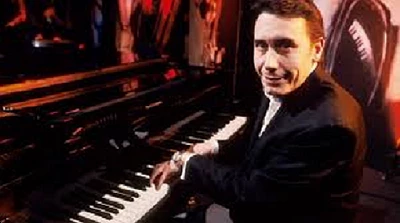published: 12 /
4 /
2015

In this 1990 archive interview Nick Dent-Robinson speaks to Jools Holland about his love of cars
Article
Jools Holland spotted something in the back of the rusty old pick-up truck in his garage. It was a battered, muddy and empty packet of 20 Players Weights. His eyes lit up with pleasure. “Ah. Just the sort of period detail I like,” he said as he stumbled on a crumbling ledge in the cabin of the pick-up, an early 1950s Austin A70 Hereford.
Jools is good at period detail, the feel of an era, the playful image. He is the 32 year-old South East London boy who is sharper than the broken glass that littered the streets where he was raised. He has done a good job of creating himself as a pop star, presenter of popular television shows such as ‘The Tube’ and ‘Jukebox Jury’, and is a man of style. But choosing style rather than fashion means doing constant battle with the question of what is stylish and what is simply naff.
Despite his growing fame and widespread acceptance as one of the finest boogie-woogie pianists of his generation, Jools chooses to stay where he grew up, among the people he knew at Shooters Hill Grammar School. These days the long-term future he dreams of is fronting a modern-day rhythm and blues big band - though the logistical challenges and costs of that are formidable. Meanwhile, he has refurbished his office-cum-studio in Greenwich in the style of an old railway station.
When Jools, in a shapeless black sweater, faded jeans and jacket embroidered with his name, drives his silver-grey Jaguar Sovereign from that office-studio to Frank’s café in Woolwich, where they still call him Julian and serve him a sardine sandwich and tea, his every action appears to be a statement of style begging to be judged.
A man’s vehicles say a lot about his style, and Jools’s progress through various self-images can be traced through his motoring. First, he was a greaser, a biker who would allow Hell’s Angels to pee on his trousers in initiation ceremonies.
“Well, that was all about being silly and driving fast,” Jools explained.“People kept falling off and seriously injuring themselves and when you’ve seen a lot of that, you suddenly think, ‘Oh dear. Probably better not’ and you move on.” Now he believes no-one under 25 should be allowed on a motorbike.
Jools still has the chrome and black Velocette bike which he purchased when he was 16 and which he loves for its luxurious curves and its detail, like the fishtail exhaust. He keeps it covered with an old tablecloth in the back of the garage and likes to give it a shine. “It should be clean like a polished piano,” he said, running his hand over the headlamp cowling. Jools commented with a grin that “tickling” the carburettor before starting the Velocette was “very sexy”, and he loved the deep, thudding note of the engine. As an aside, he added that he only wished some of his human sexual partners could be guaranteed to respond as positively to foreplay. Then he jumped on the bike’s kick-start several times, but to no avail! So no quick response this time, then? Apparently it needed a few adjustments!
Jools used to ride the bike regularly but now, rushing around the country’s concerts with his present band, the reformed Squeeze, and to New York to present television shows, he does not have the time.
A recent trip to Los Angeles, “Where I saw lots of actors riding around on big bikes with their collars turned up,” gave Jools and a few friends the idea of forming a Gentlemen’s Motor Cycling Club. “We thought we would go there wearing suits and smoking pipes and teach them how to be gentlemen,” he said.
The Club’s watchwords are “care, courtesy, concentration.” Instead of biting the heads off chickens like Hell’s Angels might, the members buy each other chicken dinners. They never roar past motorists on narrow bends, and weaving through traffic “Is only excusable when we have library books to return.”
Other members of the Club also ride 1960s British motorcycles and they are thinking of designing a Club tie. Jools would like the Austin Hereford pick-up to be the support vehicle for Club outings, the driver wearing a tweed suit and a hard hat, collecting any gentleman motorcyclist whose machine failed him or who became fatigued by its vibration.
Jools has already been through a series of flashy sports cars, mostly large 1950s American models, peaking with a 1959 Corvette Stingray. As his fame grew, he had to find something less conspicuous. The Jaguar fits the bill as a run around being British (an important consideration) and utterly tasteful, but it is still off-the-peg rather than designer style.
Jools made his choice of vehicle not by studying cars, but people. At car rallies he found himself attracted to eccentric types sitting contentedly in quiet corners on their antique vehicles, not caring a damn what anyone thought of them.
As a man who always had several high profile, high pressure projects on the boil at once, Jools was entranced by people who could spend a week trundling some ancient bit of machinery across the country to a rally to put it through its paces while nobody watches.
An old commercial vehicle was the thing for him, Jools decided, something a market trader, a scrap metal dealer or a fairground showman might have driven in the late 1950s or early 1960s. His friend, Andrew Morse, found the Austin Hereford in a barn in Kent.“It isn’t everyone’s cup of tea. It is the opposite of what’s popular at the moment,” said Jools. He had not, he insisted irritably in response to my question, deliberately gone seeking the unfashionable.
Jools is not afraid of getting his hands dirty. His piano keys used to be black with engine oil when he was a teenager. But he makes no claim to being a mechanic. These days he makes the tea and tells his friend, Andrew, where he is going wrong, when Andrew is helping refurbish the pick-up. Or Jools might simply advise him not to trap his finger in the pick-up's door.
The pick-up truck has no floors at present and is riddled with holes and rust. It is a mess. But the chassis is sound and Andrew, an electronics lecturer by profession, has begun welding the sills and the floors in the cab. Restoration will take at least a year; he will have to get parts through Austin collectors’ clubs.
Jools finds it a therapeutic respite from self-creation and the rigours of his musical career to spend hours undoing things and doing them up again. It slows you down and focuses your mind on one particular, solid thing, which I find very relaxing,” he told me.
But the Austin Hereford is also a wonderful focus for playing with image. Jools dreams of the different canopies he might put on the back of it. One with slatted sides for carrying old motorbikes, a canvas one, one like a thatched Tudor cottage with leaded bow windows and flower-filled window boxes.
“It is a Dinky Toy-type of machine. That is what appeals to me,” Jools said.
He asked what I thought of his pick-up truck. I said it had clearly seen better days, and that looking at it made me feel rather tired. “It makes me feel just like that too,” Jools said happily. “I like to come here with a cup of tea, look at the pick-up truck and feel very tired, and then go away again and refocus on my musical life. But I’ve seen Andrew start on vehicles in a worse state than this one and he gets them on the road remarkably quickly.”
“Anyway, wheels maketh the man, in my view,” Jools suddenly exclaimed profoundly. And there seemed no point in arguing with such a master of accoutrement.
Band Links:-
http://www.cornburyfestival.com
Picture Gallery:-

